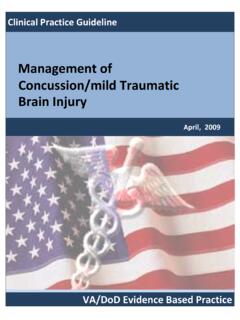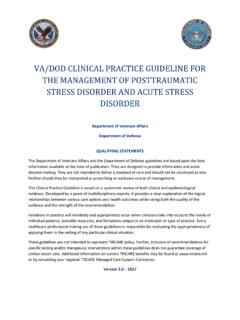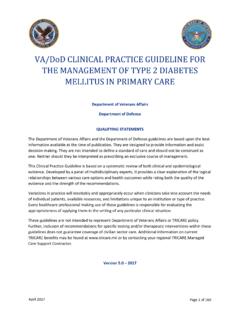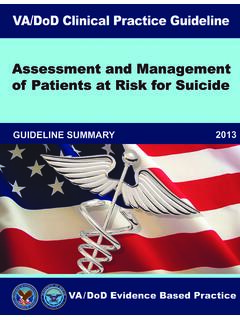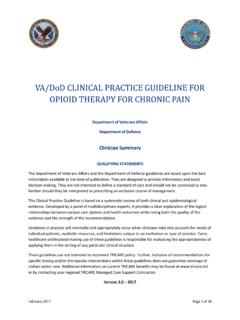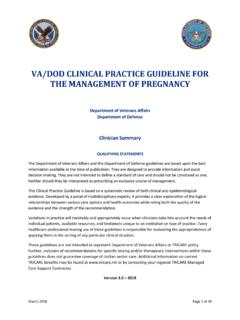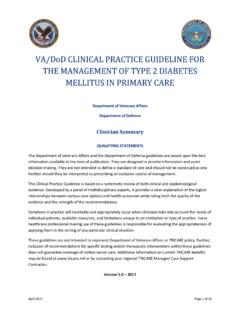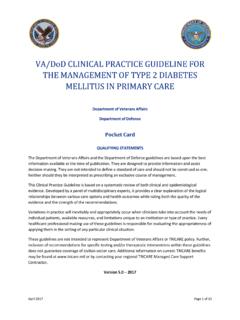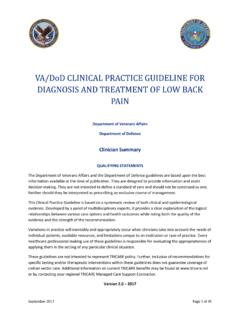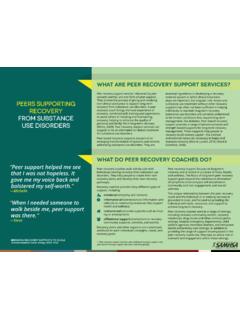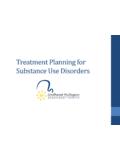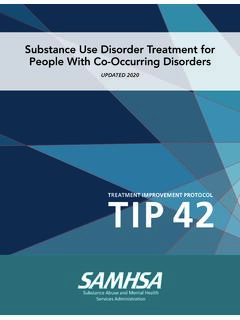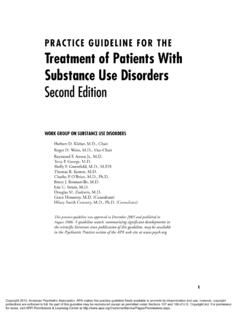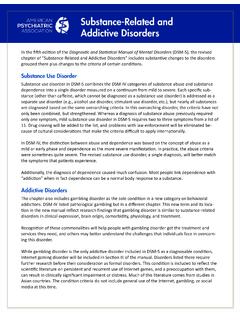Transcription of VA/DoD Clinical Practice Guideline for Substance Use …
1 VA/DoD Clinical Practice Guideline FOR THE management OF Substance USE disorders Department of Veterans Affairs Department of Defense QUALIFYING STATEMENTS The Department of Veterans Affairs and the Department of Defense guidelines are based upon the best information available at the time of publication. They are designed to provide information and assist decision making. They are not intended to define a standard of care and should not be construed as one. Neither should they be interpreted as prescribing an exclusive course of management . This Clinical Practice Guideline is based on a systematic review of both Clinical and epidemiological evidence. Developed by a panel of multidisciplinary experts, it provides a clear explanation of the logical relationships between various care options and health outcomes while rating both the quality of the evidence and the strength of the recommendation.
2 Variations in Practice will inevitably and appropriately occur when clinicians take into account the needs of individual patients, available resources, and limitations unique to an institution or type of Practice . Every healthcare professional making use of these guidelines is responsible for evaluating the appropriateness of applying them in the setting of any particular Clinical situation. These guidelines are not intended to represent TRICARE policy. Further, inclusion of recommendations for specific testing and/or therapeutic interventions within these guidelines does not guarantee coverage of civilian sector care. Additional information on current TRICARE benefits may be found at or by contacting your regional TRICARE Managed Care Support Contractor. Version 2015VA/DoD Clinical Practice Guideline for the management of Substance Use disorders December 2015 Page 2 of 169 Prepared by: The management of Substance Use disorders Work Group With support from: The Office of Quality, Safety and Value, VA, Washington, DC & Office of Evidence Based Practice , Army Medical Command Version 2015 Based on evidence reviewed through January 2015 VA/DoD Clinical Practice Guideline for the management of Substance Use disorders December 2015 Page 3 of 169 Table of Contents I.
3 Introduction .. 6 6A. Description of Substance Use disorders .. 6 B. Epidemiology and Impact .. 8 C. Factors Affecting Risk of Substance Use disorders .. 8 D. Substance Use disorders in the Department of Veterans Affairs and the Department of Defense .. 8 E. Working Toward Successful Substance Use disorders Treatment .. 9 this Clinical Practice Guideline .. 9A. Methods .. 9 Recommendations .. 2009 Clinical Practice Guideline Recommendations .. Review Process .. 12B. Conflict of Interest .. 13 C. Scope of this Clinical Practice Guideline .. 13 D. Highlighted Features of this Clinical Practice Guideline .. 14 E. Patient-centered Care .. 14 F. Shared Decision Making .. 15 G. Engagement Strategies .. 15 H. Addiction-focused Medical management .. 16 I. Accreditation Standards .. 17 J. management of Substance Use disorders in Department of Defense Healthcare Settings.
4 17 K. Substance Use disorders and Co-occurring Conditions .. 19 Use Disorder and Tobacco Use .. with Multiple Substance Use disorders .. Use Disorder and Other Co-occurring Conditions .. 19L. Implementation .. 20 Work Group .. 21V. Algorithm .. 22 A. Module A: Screening and Treatment .. 23 B. Module B: Stabilization .. 24 VI. Recommendations .. 25A. Screening .. 29 VA/DoD Clinical Practice Guideline for the management of Substance Use disorders December 2015 Page 4 of 169 B. Brief Alcohol Intervention .. 31 C. Determination of Treatment Setting .. 32 D. Treatment .. 33 Use Disorder .. Use Disorder .. Use Disorder .. Use Disorder .. 48E. Promoting Group Mutual Help Involvement .. 50 F. Co-occurring Mental Health Conditions and Psychosocial Problems .. 52 G. Follow-up .. 52 H. Stabilization and Withdrawal.
5 55 .. Use Disorder Stabilization and Use Disorder Stabilization and Withdrawal .. Hypnotic Use Disorder Stabilization and Withdrawal .. Gaps and Recommended Research .. 63A. Determination of Treatment Setting .. 63 B. Pharmacotherapy .. 63 Use Disorder .. Use Disorder .. 63C. Psychosocial Interventions .. 64 Use disorders .. Use Disorder .. 64D. Follow-up .. 64 E. Stabilization and Withdrawal .. 64 F. Telehealth .. 64 Appendix A: Evidence Review Methodology .. 65 A. Developing the Scope and Key Questions .. 65 (s) .. 66B. Conducting the Systematic Review .. 67 for Study Search 71C. Convening the Face-to-face Meeting .. 71 D. Grading Recommendations .. 72 E. Recommendation Categorization .. 75 Categories and Definitions .. 75VA/DoD Clinical Practice Guideline for the management of Substance Use disorders December 2015 Page 5 of 169 Recommendations with an Updated Review of the Evidence.
6 Recommendations without an Updated Review of the Evidence .. 77F. Drafting and Submitting the Final Clinical Practice 77 Appendix B: Pharmacotherapy for Alcohol Use Disorder and Opioid Use Disorder .. 79 Appendix C: Psychosocial Interventions .. 91 A. Behavioral Couples Therapy .. 91 B. Cognitive-Behavioral Coping Skills Therapy .. 92 C. Community Reinforcement Approach .. 92 D. Contingency management for Substance Use disorders Treatment .. 92 E. Individual Drug Counseling .. 93 F. Motivational Enhancement Therapy .. 93 G. 12-Step Facilitation .. 93 Appendix D: Evidence Table .. 94 Appendix E: 2009 Recommendation Categorization Table .. 101 Appendix F: Participant List .. 129 Appendix G: Conflict of Interest Disclosures Based on Financial Relationships with Industry .. 131 Appendix H: Literature Review Search Terms and Strategy.
7 132 A. Topic-specific Search Terms .. 132 B. Search Strategies .. 138 Appendix I. Acronym List .. 149 References .. 152 VA/DoD Clinical Practice Guideline for the management of Substance Use disorders December 2015 Page 6 of 169 I. Introduction The Department of Veterans Affairs (VA) and Department of Defense (DoD) Evidence-Based Practice Work Group (EBPWG) was established and first chartered in 2004, with a mission to advise the ..Health Executive Council on the use of Clinical and epidemiological evidence to improve the health of the population across the Veterans Health Administration and Military Health System, by facilitating the development of Clinical Practice guidelines (CPGs) for the VA and DoD populations.[1] This CPG is intended to provide healthcare providers with a framework by which to evaluate, treat, and manage the individual needs and preferences of patients with Substance use disorders (SUD), thereby leading to improved Clinical outcomes.
8 In 2009, the VA and DoD published a CPG for the management of Substance Use disorders (2009 SUD CPG), which was based on evidence reviewed through 2007. Since the release of that Guideline , a growing body of research has expanded the general knowledge and understanding of SUD. Improved recognition of the complex nature of these conditions has led to the adoption of new strategies to manage and treat patients with SUD, including new developments related to pharmacotherapy and other treatment options. Consequently, a recommendation to update the 2009 SUD CPG was initiated in 2014. The updated CPG includes objective, evidence-based information on the management of SUD. It is intended to assist healthcare providers in all aspects of patient care, including, but not limited to, diagnosis, treatment, and follow-up. The system-wide goal of evidence-based guidelines is to improve the patient s health and wellbeing by guiding health providers who are taking care of patients with SUD along the management pathways that are supported by evidence.
9 The expected outcome of successful implementation of this Guideline is to: Assess the patient s condition and determine in collaboration with the patient the besttreatment method Optimize each individual s recovery to decrease or eliminate consumption, improve health andwellness, live a self-directed life, and strive to reach his or her full potential [ 2] Minimize preventable complications and morbidity Emphasize the use of patient-centered Description of Substance Use disorders SUD can develop in individuals who use alcohol or other addicting drugs in harmful quantities. About 9% of Americans over age 18 have a non-tobacco SUD, and about one in every four Americans will develop a non-tobacco SUD over the course of a lifetime.[3,4] According to the Centers for Disease Control and Prevention (CDC), excessive alcohol use costs the United States ( ) over $ billion annually.
10 [5] According to the Department of Justice, the estimated cost of illicit drug use in the was more than $193 billion (in 2007).[6] This reflects direct and indirect public costs related to crime ($ billion), health ($ billion), and lost productivity ($ billion).[6] Excessive alcohol use itself leads to about 88,000 premature deaths each year from acute ( , alcohol poisoning, motor vehicle accidents) and chronic causes ( , liver disease, hypertension, heart disease, stroke, pancreatitis). SUDs including tobacco VA/DoD Clinical Practice Guideline for the management of Substance Use disorders December 2015 Page 7 of 169 represent the leading actual cause of death in the [7] While the costs to our nation s health are high, healthcare professionals are in a unique position to positively impact the health and wellbeing of the Service Members and Veterans they treat by implementing effective SUD prevention and treatment strategies.
